Separation Anxiety in Adults & its Effects on Everyday Life
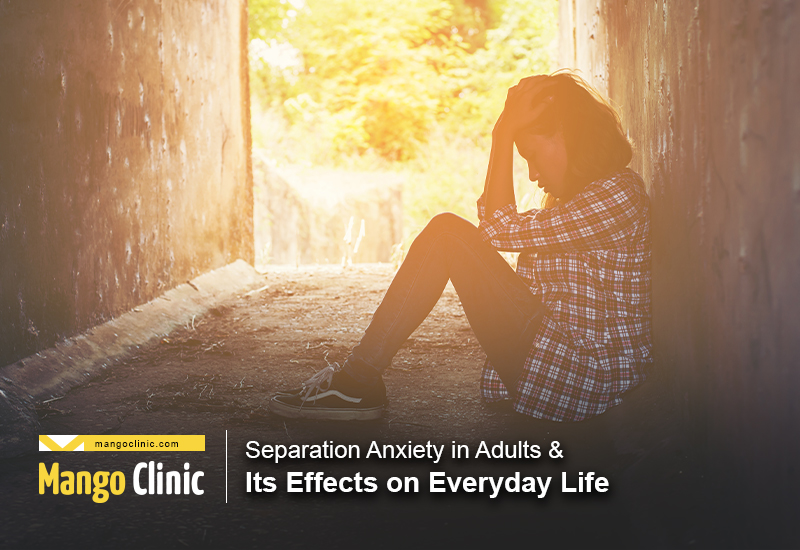
Separation anxiety disorder is a significant mental health problem affecting children and adults. This disorder manifests as excessive fear/ worry about separation from home, person, or an object of affection. This is a severe mental health condition that can lead to panic attacks, depression, and other serious consequences in adults. It’s important to remember that separation anxiety disorder affects children and can also affect adults.
The DSM-5 identifies this condition as a clinical diagnosis. It’s not random. In the past, experts believed it was a developmental disorder only affecting children. Recent research indicates that separation anxiety affects adults as well. Currently, the diagnostic criteria are extensive and include adults.
Proper anxiety treatment can save you from SAD problems. Click the button below to book your appointment.
This post brings to light everything you need to know about separation anxiety disorders, diagnosis, treatment, and living positively with them. Let’s zoom in.
Table of Contents
1. What Is Separation Anxiety?
Anxiety is a familiar theme in the story of the human race. We naturally become sad when we are apart from friends or family members. So is separation anxiety a mental illness? SAD is a mental health problem tied to genetics, the environment, and brain chemical imbalances. Worry and fear over isolation or missing someone/ something will be a familiar recurring phenomenon if you have SAD.
Young adults in countries such as the United States are more likely to struggle with SAD when they start living independently from an early age. Individuals in this group live isolated from their families and may be forced to sacrifice social lives for professional growth.
Re-traumatization can also occur among older adults who have experienced a loved one’s death or significant tragic events that made them feel isolated from loved ones at a young age. In children and infants, separation anxiety disorder is not an uncommon diagnosis. The suffering caused is not limited to children—it also affects parents and caregivers. Since this is a prevalent problem, clinicians have focused on it for years.
Adult separation anxiety is now in the scientific spotlight due to a growing number of cases—adults who have experienced separation exhibit distinct signs, complications, and symptoms.
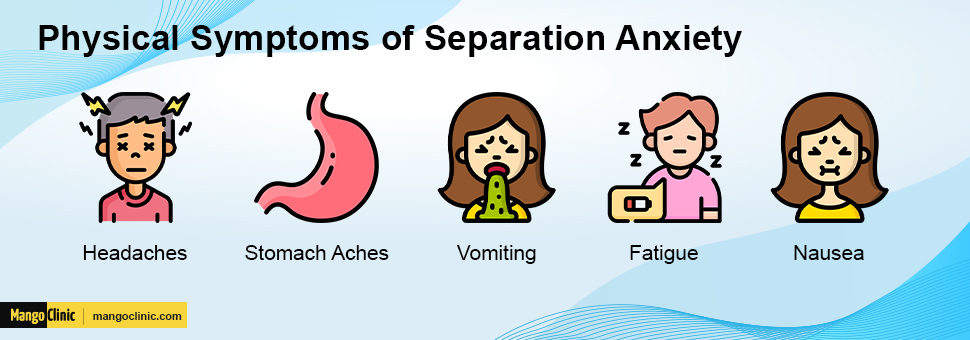
Separation Anxiety in Adults: a Look Back at History
Separation anxiety disorder became a recognized diagnosis in the 1990s, and it was recognized separately from anxiety in children and adolescents. Researchers in Australia-Sydney conducted primary research on self-referred and admitted patients under the guidance of clinicians, experts, and hospital workers at the time.
Silove and colleagues developed the Anxiety Symptom Inventory (SASI) in 1993. They created a psychometric test to measure separation anxiety in adults. This tool has served in numerous studies, researches, and experiments. Ultimately, it led to factual findings and data around the novel disorder.
However, initially, results did not distinguish separation anxiety from panic disorder. Over the years, studies have shown that patients with panic disorder who initially seem to respond well to cognitive-behavioral therapy appear to have a significant relapse rate after a while.
From these observations, separation anxiety stood out as a stand-alone condition with distinct and unique symptoms. Researchers in 1999 described the first symptoms of separation anxiety among adults.
What Are the Clinical Observations in Separation Anxiety?
As noted by Vijaya Manicavasagar and Derrick Silove, the earliest clinical observations of separation anxiety in adults were:
- People anxiously attached to their romantic partners, parents, and children showed the most severe symptoms.
- Worrying about family members, safety concerns, and health concerns.
- Being constantly concerned about the health and safety of the person they are attached to.
- In all the above cases, the individuals demonstrated immense fear beyond the ability to calm down when assured.
- The anxiety and fear interfered with their daily activities and distracted them.
- At an initial stage of their discomfort, these adults tried self-constructed coping mechanisms to suppress their symptoms, including humor, rationalization, and normalization.
- No matter, their SAD-driven maladaptive behaviors, and fears would soon get out of control and become apparent to everyone.
Save yourself from the risks of anxiety. Click the banner below to book your appointment.

2. Diagnosis and Symptoms of Separation Anxiety in Adults
In the aftermath of separation, individuals with SAD experience extreme anxiety. They may also experience physical symptoms such as headaches, nausea, and sore throat. It’s important to note that separation anxiety in adults can sometimes stem from their childhood. However, some people only experience separation anxiety as adults.
Adult separation anxiety can trigger severe health problems that go beyond the symptoms of acute stress. People experiencing these episodes sometimes feel the need to be near someone they’re close to at all times. According to the DSM-5, separation anxiety as a mental health condition is characterized by several of the following symptoms:
- Immense emotional anguish after separation from a favorite person, thing, or pet.
- Intense fear over an impending separation.
- Fear that harm may befall the person, thing, or pet after the separation.
- Scared of being lonely.
- Physical symptoms as described earlier.
- Feeling obsessively possessive about a spouse, pet, or thing.
Let’s be practical. We all come under stress when separated from loved ones/ things/ pets from time to time. So when does that stress become SAD? You might have also heard that many people face difficulties getting through the day when feeling anxious. There are quite a few people who experience this every day! So why can’t everyone just ‘get over it,’ you ask?
Well, the thing is that if the stress or thought of missing someone is leading to significant impairment in their life, then there’s a problem. These individuals may avoid certain situations, environments, or social interactions that cause them to be apart from their loved one or thing. This is considered an anxiety disorder, and it warrants seeking medical/ psychiatric intervention.
Separation anxiety tends to make people withdraw from social interaction and live alone. Their daily routines and professional lives become impacted by high levels of stress, sadness, and hopelessness.
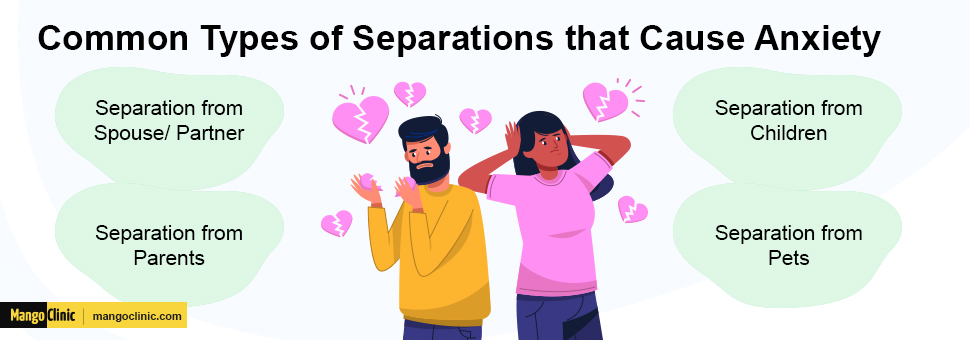
How Separation Anxiety Can Affect the Life of an Adult?
Symptoms of SAD can last for six months or even more in adults. Its symptoms can be so severe that they affect their daily activities by affecting their social, occupational, and academic functioning. Here is a deep-dive assessment of how SAD may affect the lives of an adult.
Emotional Anguish
The condition may derail the joy of life and the social or professional growth of an adult through intense:
- Shame
- Sadness
- Fear
- Anger issues
- Helplessness
- Embarrassment
- Worry
- Inability to get meaningful employment
- Disinterest in trying new things or participating in new activities
Behavioral Peculiarities
Individuals with SAD may have behaviors deemed as strange that further lead to more isolation:
- Cannot go out without friends and family
- Problems trusting others
- “Sick leaves” that are not really sick leaves
- Nightmares and night terrors
- Incapable of attending events alone
Negative Outlook in Life
If left untreated, SAD can cripple an individual’s life through:
- Continuous fear that your possession or loved one will encounter an ill fate
- Involuntary negative visualizations about losing a loved one or item
- Feeling that your loved ones may forget you
- Thoughts about getting attacked
- Worry about having to stay late at a social event
Looking for medicinal anxiety treatment? Click the button below to book your appointment
Psychosomatic Symptoms
SAD can have symptoms that go beyond the mind to affect the body:
- Nausea
- Rapid heartbeat
- Vomiting
- Headache
- Difficulty breathing
- Stomach issues
How Is Separation Anxiety Diagnosed in Adults?
Only certified health experts are qualified to diagnose separation anxiety in adults. A health professional will evaluate your signs and symptoms based on the following DSM-5 criteria:
- Attachment to people or objects leads to improper development, excessive anxiety, and fear. Examples include:
-
- Fear of losing family members or essential things
- Anxiety about losing someone, getting injured or sick, etc.
- The constant fear of facing destructive events such as losing loved ones, getting into a car accident, being kidnapped, etc. that could cause separation
- Refusal to leave the house for school or work
- Anxiety about being alone or without the attachment figures
- Refusing to sleep anywhere except at home or near the attachment figure
- Separation themes in nightmares
- Recurrent complaints of stomach aches, headaches, nausea, and vomiting
- Symptoms of the disorder include fear, anxiety, and avoidance, among others. For children and adolescents, the qualifying duration for these symptoms is four months and six months for adults.
- The patient should show clinical signs of distress and impairment in various areas, such as occupational, social, academic, and other aspects of health.
- The condition should not be or part of autism spectrum disorder, hallucinations, agoraphobia (an inability to leave the house), or other mental health disorders
Experts warn that psychological disorders – including depression – may share symptoms with SAD. Hence the need for differential diagnosis. Some of the conditions that may be confused with SAD include:
- Agoraphobia
- Conductive disorder
- Bipolar disorder
- Panic disorder
- Schizophrenia
- Generalized anxiety disorder
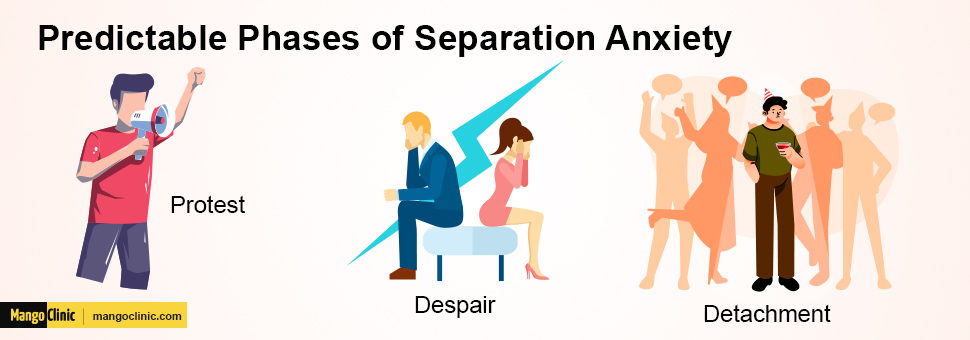
3. What Causes Separation Anxiety in Adults?
Separation anxiety typically occurs during childhood, but it can remain a problem for life. There are many causes and risk factors for developing adult separation anxiety disorder. Many people do not even realize that they have the condition because it has, signs similar to panic attacks or social phobia. So far, the speculated causes of SAD include:
Prior Traumatic Events in One’s Life
Very often, traumatic events from earlier in life can lead to separation anxiety in adulthood. Traumatic events may include the loss of a loved one through death or divorce, argumentative behavior from a spouse or partner, or even kidnapping.
Genetic Influences
Genes play a considerable role in whether or not you’re going to have a separation anxiety disorder. Studies suggest that genetic predisposition accounts for a whopping 73 percent of a person’s probability of developing SAD. Experts believe that if at least one parent has a history of separation anxiety disorder, the child is more likely to develop this disorder. Other factors that can increase a child’s chances of developing SAD include a history of depression in themselves or a family member, parental stress, a chaotic household life, divorce, and a lack of parental attention.
Environmental Factors
Several environmental factors are responsible for the development of SAD and other mental health disorders, such as anxiety and depression. These factors may include abuse by parents, child abuse, lack of parental support or essential grooming and care, divorce in the family, domestic issues, and financial problems related to the bare living essentials.
Brain Chemistry
Experts believe that the neurotransmitter system plays a role in the development of SAD. A neurotransmitter is a chemical signal that communicates between brain regions and regulates behavior. For instance, dopamine is a neurotransmitter that aids in mood regulation and acts as a catalyst in behavior. Hence, low levels of dopamine may contribute to feelings of depression and other mood disorders.
Exposure to Danger
A person who lives near a battlefield or in an area rife with street crimes is more likely to develop separation anxiety. For safety reasons, people may not feel secure among other people. For this reason, they are likely to isolate themselves from their community, fearing other people rather than engaging with the world around them.
Unhealthy Possessiveness
In some individuals, SAD can be linked to certain behaviors. People who exhibit these behaviors may be fearful, jealous, or have an obsessive desire to possess another individual beyond the definition of a normal relationship. These people may find it challenging to share their things or loved ones with somebody else, especially when dealing with new children in the family.
Contact Us now for proper anxiety treatment or click the banner below to book your appointment.

What Are the Risk Factors of Separation Anxiety?
As seen above, environmental and parental factors can lead to social anxiety disorder, but experts have identified several other mental health disorders as causes of SAD. Those include:
- Panic disorder
- Personality disorders
- Post-traumatic stress disorder (PTSD)
- Social anxiety disorder
- Generalized anxiety disorder (GAD)
Separation Anxiety Has Three Phases. What Are They?
In children and adults, there are three predictable phases of separation anxiety.
Stage 1: Protest
In the first phase, people are likely to react in anger and rage when forced to separate from the person or object of their attachment. People tend to look around and seek attention from the attachment figure.
Stage 2: Despair
Second, you start giving up everything you have in your life in the stage of ‘despair.’ A sense of hopelessness and inactivity characterizes this stage, and feelings of helplessness.
Stage 3: Detachment
During the final stage of ‘detachment,’ a person superficially attaches to others to cope with their sorrow. While this might seem like a quick fix, it would do more harm than good by turning you into a self-centered individual.
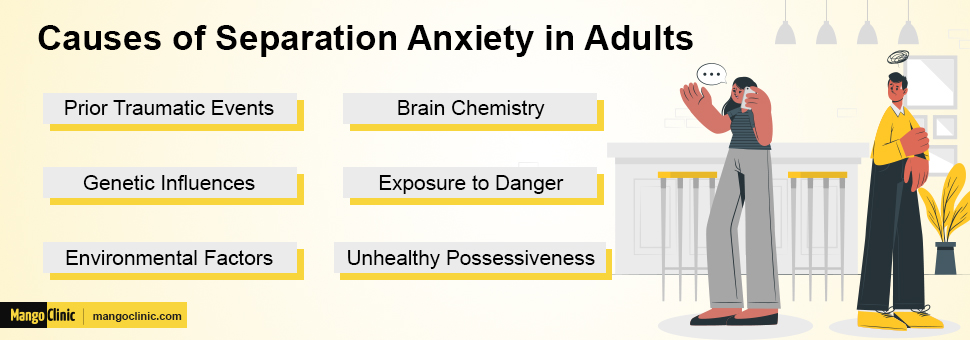
4. Separation Anxiety in Adults Vs. Children Vs. Teenagers
Five to thirteen-year-olds are often affected by separation anxiety. An individual with separation anxiety fears leaving a loved one or a comfortable place, but by the age of thirteen, it usually goes away by itself.
Separation Anxiety Disorder Adults Vs. Children
| SAD in Adults | SAD in Children |
| Anxiety over separation occurs in adults rarely and is a mental disorder. | Children experience separation anxiety during their early developmental years. |
| SAD symptoms in adults can be easily recognized and acknowledged as an anxiety state. | When children are experiencing anxiety related to separation, they are incapable of expressing their feelings to others. |
| The constant fear of losing the object of attachment | The constant fear of losing the object/ subject of attachment. |
| Health and safety issues | Nightmares |
| Anger | Fear of getting lost |
| Rage | Hesitancy |
| Depression | Anger |
| Slacking on job and responsibilities | Avoidance of activities |
| Jealousy | Trouble making friends |
| Isolation and self-centered personality |
Outlook for Children with SAD
Children with separation anxiety may exhibit many of the symptoms described above. In such cases, it is essential to seek help from a mental health professional for a complete diagnosis and a treatment plan to ensure a positive outcome. Whenever dealing with a child with SAD, it is essential that all key figures in the child’s life get involved, including family members, teachers, and siblings.
A baby with a separation anxiety disorder is not the only one who will suffer immensely. The parents who care for them will also be at a loss of what to do or say. Fortunately, if the disorder is properly treated and managed early on, these children are more likely to live a normal and fulfilling life.
Can a Teenager Have Separation Anxiety?
Separation anxiety disorder can also affect adolescents, although they are likely to deny any symptoms at this age. SAD can manifest itself through deviant behavior. Also, signs such as the inability and reluctance to leave home, being overly health-conscious, expressing dissatisfaction with their physical body changes, difficulty performing independent tasks, refraining from attending school are common symptoms of teenage SAD.
How to Help a Teenager with a Separation Anxiety Disorder?
If your teenager is willing to open up about his feelings about separation, pay attention to them and gain their trust. Provide them with ways to understand their anxiety triggers as well as situations that cause the most anxiety. It is essential to show them that you care and support them. By recognizing their problems, they may be able to reduce the intensity of their symptoms and worries.
Assure them that the symptoms of their condition are treatable. Teenagers do not often disclose their weaknesses; give them time to work on coping mechanisms independently. If the teenager has trouble coping with social activities and gatherings, the best course is to seek professional help. A specialist can provide various options for coping with their symptoms and devise the best treatment plan for their conditions.
Get immediate anxiety treatment and live a normal life. Click the button below to book your appointment.
5. The Top 4 Separations that Cause Anxiety
Adults can suffer from separation anxiety when cut off from someone or something they may have grown accustomed to. Common types of separations that cause anxiety include:
1. Separation from Spouse/ Partner
Being away from family and friends is not an easy thing. When an individual is away from their spouse or life partner, anxiety and depression can increase. People suffering from separation anxiety spend most of their lives dreading parting from their partner or spouse. Experts believe that separation from a spouse can have drug-withdrawal-like effects on the brain.
2. Separation from Parents
Children often display separation anxiety when they are without their parents. Children under six months old frequently rely on their parents for basic needs like warmth, food, and safety; therefore, leaving them makes them feel unprotected.
Unable to comprehend why Mum isn’t there anymore, young children feel fearful and vulnerable in her absence because they can’t reason that she will come back soon. Older children (between 6 months and puberty) may cry or refuse to go to school after their mother has left; however, this state is temporary.
3. Separation from Children
Adults may develop SAD when separated from their babies or children, especially if a parent has experienced miscarriage, death, or a missing child. Separation anxiety from children when they leave for school is another challenge that first-time parents face. For some parents, separation anxiety can arise due to birth trauma or merely from becoming first-time parents.
4. Separation from Pets
In many cases, owners treat their pets like family members. The owner of a pet may consider it their closest companion. In that case, when the adult is separated from their pet, they may suffer from separation anxiety. The following are examples of symptoms related to separation anxiety in pets:
- Irrational fears about accidents
- Finding reasons to stay home with pets
- Avoiding social activities
- Inability to stay focused
- Excessive obsession with animals
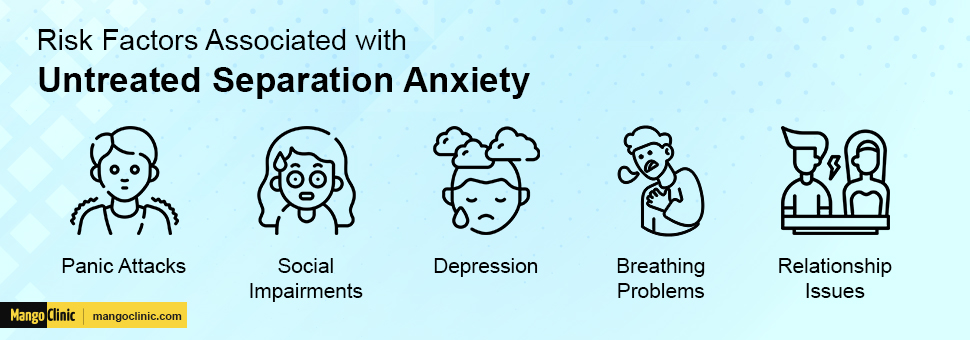
6. What Happens if Separation Anxiety Is Left Untreated?
When it comes to separation anxiety, adults can face even more socially isolating difficulties than children do. A significant percentage of the general population struggles with this condition, so it’s not unusual. This may be something to consider working out with a professional in a clinical setting. But for now, let us explain the risk of not seeking help for those living with SAD.
Panic Attacks
Separation anxiety in adults can cause panic attacks. Panic attacks can contribute to complications such as rapid heartbeat, palpitations, chest pain, and fever. During a panic attack, the human body goes into “fight or flight” mode to ensure its safety in the case of an emergency.
However, when not faced with an emergency, this onset of adrenaline causes undue stress & confusion on the body, leading to heart problems, high blood pressure, rapid breathing, irregular heartbeat, and difficulty catching one’s breath.
Social Impairments
People suffering from separation anxiety disorders are affected in their personal and professional lives. Those affected tend to become self-conscious in public or during social interactions due to the fear of losing or offending those they care about. A severe case involving separation anxiety may leave the affected towards the following outcomes:
- Poor academic performance
- Extreme behaviors
- Inactivity
- Inability to complete responsibilities
- Lethargy
- Sudden mood swings
- Absence from workplace
- Inability to focus or concentrate on anything
- Social isolation
Depression and Other Mental Health Issues
The consequences of chronic separation anxiety can lead to depression. The complications can be varied, depending on the people affected. A young individual with SAD may begin to exhibit some erratic behavior while at school. He might then become dependent on drugs and alcohol, followed by a more extreme case of depression.
Breathing Problems
Panic attacks and separation anxiety typically have symptoms such as rapid and shallow breathing. As the degree of anxiety increases, symptoms become more intense.
Relationship Issues
Children who suffer from anxiety issues can avoid future romantic relationships. It becomes hard to maintain healthy relationships because they constantly worry about separation, accidents, deaths, and the sufferings of their loved ones.
There are a lot of issues people with separation anxiety deal with, but not everyone will understand what they are going through. Overprotectiveness and constant worries can create doubt in your partner, leading to broken relationships and divorce.
Childhood Complications
Children who live in a home full of parental separation might secretly dread going to sleep for fear that their parents have abandoned them. Though children’s emotions are difficult to understand, they can leave a damaging psychological scar that lasts well into adulthood if not addressed.
Overcome symptoms of anxiety and click the banner below to book your appointment.

7. Separation Anxiety Treatment for Adults
The most common treatment for separation anxiety is psychotherapy, often combined with medication. Your doctor will prescribe medicines according to your symptoms and prescription. The following psychotherapies can help with separation anxiety symptoms and complications:
Cognitive-Behavioral Therapy
In cognitive-behavioral therapy, you will meet your therapist and interact with them to understand why you confront anxiety, nervousness, or fear on different occasions. Then, you will work towards correcting them by figuring out what exactly triggers your anxiety. The primary goal of CBT is to get rid of negative thoughts that give rise to irrational fears.
CBT can be very beneficial for individuals suffering from a separation anxiety disorder because it promotes their awareness of self-destructive behaviors and replaces them with healthy coping mechanisms.
Cognitive-behavioral therapy also teaches you ways to minimize ongoing anxiety attacks triggered by certain stimuli if caught early enough. It has been proven that cognitive-behavioral therapy paired with medication or on its own can yield positive physical results for those suffering from a separation anxiety disorder. The therapy can help with:
- Prevention of panic attacks
- Managing SAD symptoms like stress and worry
- Identifying and avoiding stressors and trigger factors
- Creating a coping mechanism for symptoms management
- Relieving physical symptoms of separation anxiety
CBT works wonders in combination with other therapies. It’s often considered both an excellent supplement and an excellent replacement for pharmacological approaches. It also happens to be the best way to work with anybody who’s taking medications.
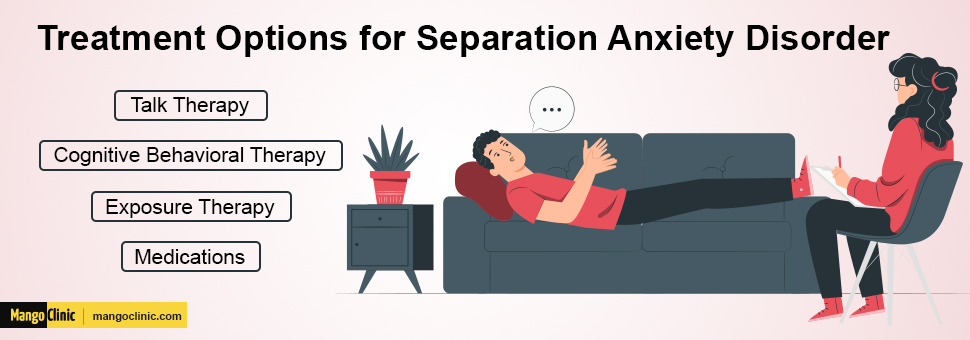
Medication for Separation Anxiety
Separation anxiety does not have a specific medication. Your certified health expert prescribes and doses your medication and therapy based on your particular symptoms. Adult separation anxiety is most commonly treated with SSRIs.
SSRIs, or selective serotonin reuptake inhibitors, are a class of antidepressants. These work by increasing serotonin levels in the brain. Serotonin is a brain chemical responsible for regulating mood and behavior. In general, SSRIs for SAD include the following:
- Escitalopram (Lexapro)
- Citalopram (Celexa)
- Paroxetine (Paxil, Pexeva)
- Fluoxetine (Prozac)
- Sertraline (Zoloft)
Lifestyle Changes
Self-management strategies are also helpful in managing symptoms of separation anxiety in adults.
SAD Education
It can seem like there is no end in sight when you have a separation anxiety disorder. But undergoing a proper education about the condition and its features might be the answer for a full recovery. Understanding your mental condition allows you to learn more about what triggers your physical reactions and the treatments available.
Wellness Activities
People with SAD can enhance the quality of their lives by indulging in wellness-focused activities. Let’s say you exercise at least 30 minutes a day, practice yoga or other low-impact exercises daily, and get a lot of sleep at night. In that case, you can greatly ease symptoms related to anxiety and chronic stress. You will also experience less separation anxiety.
Follow your treatment plan: This is easy when you have a good support system in place. Keep up with your medication schedule and follow your doctor’s treatment plan. You should never be alone in managing your mental health. Many people are ready to help you in the recovery process – such as therapists, mentors, and advocates.
Put it into practice: You need to practice anxiety coping skills and be aware of triggers and causes to use them effectively. This will allow you to handle anxiety episodes effectively and reduce your risk of relapse. It will also help you cope with any future loss or separation.
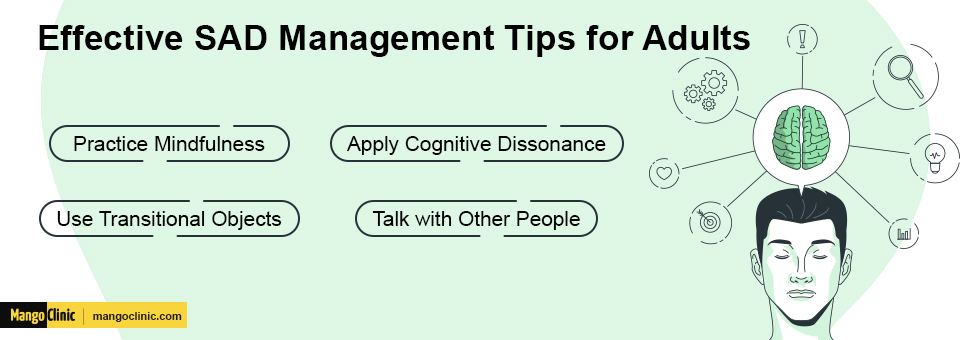
8. How to Deal with Separation Anxiety in Adults?
If you are suffering from separation anxiety, you can take steps to overcome it. Like with other challenges in life, overcoming separation anxiety requires one to be committed and have the will to overcome their fears. While writing down feelings may seem trivial, this exercise has been proven successful in reducing triggers by teaching people how to better deal with their emotions.
The more you practice deep breathing techniques during stressful situations, the easier it becomes for your mind to relax and de-escalate any physical or mental stress that comes hand-in-hand with anxiety attacks. Other things that may help you live positively with SAD include:
1. Master the condition – Understand separation anxiety symptoms, causes, and risk factors, whether you want to help yourself or support someone else. If you understand how this mental disorder affects the one suffering from it, you will relate to it.
2. Be supportive – Empathy and support can ease the symptoms of a person. Recovery times for mental health disorders can improve dramatically with proper care and support. Those struggling with SAD themselves should not neglect those who want to interact with them and care for them.
3. Be patient – Keep the faith, no matter what symptoms you have or how your treatment plan goes. Be patient when coping with separation anxiety, whether it’s yours or someone else’s. Time is a factor for healing.
4. Trust – Trust in your therapist and in your mind’s power to heal. Each person will react differently to a particular disorder and treatment options. Ultimately, therapy and recovery will work one way or another, even if it takes some time for some.
5. Get professional help – Getting professional help is recommendable for those living with separation anxiety. Sadly, few people with this condition ever receive a diagnosis. Most disregard their symptoms or mistake them for personality disorders. Still, if left untreated, SAD may lead to suicidal thoughts, self-harm, and drug overdose. A certified professional can prescribe you appropriate medication and various treatment options.
6. Follow a plan – A person with SAD is susceptible to anxiety attacks at any time. Developing an action plan allows you to calm yourself and ask for help when you are experiencing peak times of anxiety. Below are a few pointers:
- Positive thinking
- Yoga and mindfulness
- Progressive muscle relaxation exercises
- Talking to your loved ones
- Surrounding yourself with the objects that inspire fond memories
- Deep breathing exercises
- Sticking to your happy place
Keep in mind that an action plan will not eliminate separation anxiety. It only makes it easier to tolerate your symptoms better and reduce their intensity.
Want help with anxiety? Click the button below to book your appointment.
Outlook
Adult separation anxiety can be mild to severe. It has an extensive range of symptoms—the level at which a patient experiences separation anxiety will depend on their medical history. Suppose a person develops this disorder at a young age. In that case, they will continue to experience it throughout their lives, possibly worsening as time goes on if they do not receive treatment for their condition.
Even though researchers have not firmly established the exact causes behind separation anxiety, there are solid theories that can get you closer to understanding why patients may develop a separation anxiety disorder and how it manifests physically and internally. Although this disorder can be excruciatingly painful for the patients, seeking professional help can ensure that you get better and live positively regardless of the diagnosis.
Contact us at Mango Clinic for anxiety treatment or click the banner below to book your appointment.





